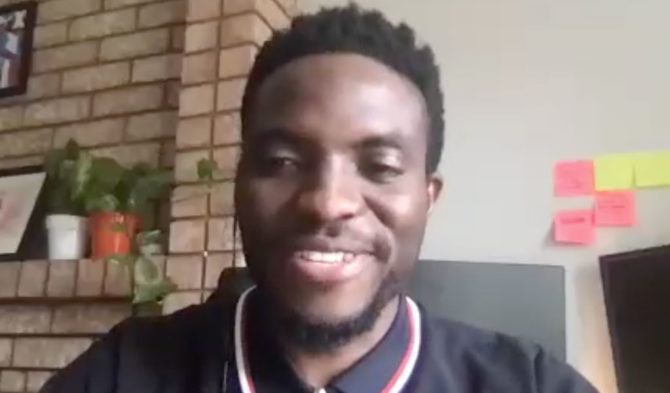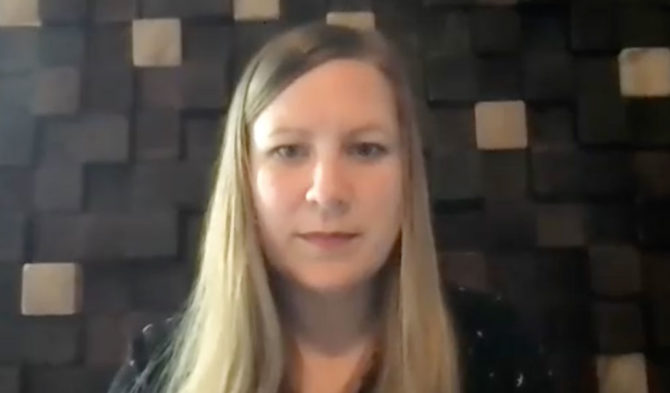3 Things You Should Know About Being a Graphic Designer: Grads Share Their Thoughts
Two recent graphic design grads recently made a virtual return to the Toronto Film School classroom to share their experiences and offer advice to current students.
Dami Osoba, an alumnus of the on-campus Graphic Design & Interactive Media program, and Melissa Milks, an Online Graphic Design & Interactive Media graduate, were the latest guests to take part in Meet the Designers.
The once-a-term event presents a unique opportunity for graphic design students to gain insight into the real world of creative professionals and to be inspired with a diversity of design ideas and approaches.
“We run these to give all of our students, faculty and the entire program an opportunity to glean some more insight from different perspectives about what it’s like to be a creative professional,” explained Pheinixx, director of the Graphic Design & Interactive Media program.
“The format that I give to all our guests is very open and it’s based around three things that they would like to share – and it’s entirely up to them. I don’t even have any idea what anyone’s going to say, so it’s always a very exciting and fun event for me, too.”

Before enrolling at Toronto Film School, Osoba worked in IT at a bank here in Toronto. It was while searching for a more ‘creative and fulfilling’ career that he stumbled upon the Graphic Design & Interactive Media program and signed up right away.
“It was during that course that I found out about interactive design and UI/UX (user interface/user experience),” Osoba said. “Ever since then, that has sort of been my passion and my career path has been really interesting.”
After graduating from TFS in 2018, Osoba moved to Montreal for a five-month opportunity as a UX intern, before moving back to Toronto for his current job as a UI/UX designer for the digital agency, Reshift Media. He also freelances for small business and startups.
Here are the 3 things he shared:
1) Know Your Specialty
“You need to know your specialty. As basic as it sounds, it’s very important because TFS gives you the opportunity to explore all different areas of design…you have typography, you have motion design, you have illustration, you have so many things. For myself, I got kind of lost in all the many areas of design. I needed to find out where my strengths were and how I could leverage them. You can only find your specialty by exploring, so I really recommend you explore and take each assignment as an opportunity to visualize yourself doing that for a living…That’s how I found out about interactive design and UI/UX. I really saw myself doing that to make a living, because I found it really challenging and interesting. There’s nothing wrong with being a generalist, but in the world you’re going into, people appreciate other people who have dedicated themselves to a specific field.”
2) Practice With Intention
“When you decide what you want to focus on, you need to smart practice – and what smart practice means is practicing with intention. There’s this saying that you need 10,000 hours to be good at something and that’s true to an extent, but you also need to be intentional in how you practice. In my case, I wasn’t good at using colours. I wasn’t sure what colours to use to communicate visually, so it was important for me to put more intention into the specifics of colours and understanding colour theory and how colours work together. So, every time I designed, I wasn’t just designing in general, I was trying to improve my UI/UX cues. I would pay more attention to the colours. Whatever area you feel you’re not the strongest at, I would say dedicate some extra time and extra effort to that specific area and you will see yourself improve at a faster rate than if you were just practicing in general.”
3) Share Your Work
“The biggest one for me is sharing your work. This is very important. As a designer, I got to a stage where I thought everything had to be perfect, so I wasn’t really willing to share my work. I just wanted to keep everything on my computer, but after a while, it all piled up. You need to get your work out there, which can feel scary at times, but that’s okay. That’s part of the journey of you becoming the kind of designer you need to be…Once you start to show your work, you’re going to get feedback. Understanding how to accept feedback and deal with feedback is very important on your journey to becoming a designer. You’re going to be working with creative directors at a management level and they’re going to be giving you feedback on your designs, which will not always be positive. So, understanding how to detach yourself from your work is very important. That’s something I’ve learned along the way. I now understand that opinions about my designs don’t define me as a person. That mindset comes with time. Once you start to show your work, you can build up the confidence you really need to improve.”

For Milks, the path to pursuing her passion for graphic design was one that initially saw her explore several other career options along the way. Like Osoba, she worked in IT for a time before discovering her interest in design.
“And, although I was good at it and I liked it, I wasn’t the happiest with it,” said the mother of three, explaining that she took on several other jobs before landing at Toronto Film School – even one as a daycare provider while she raised her kids.
“I actually did online schooling while working full-time as a daycare provider, so it was a busy few years, but within a couple of months, I was able to get the job that I have now.”
Currently a graphic designer for a large print company in Mississauga called CJ Graphics, Milks took her opportunity in the Meet the Designers spotlight to talk to students about what living with aphantasia – the inability to visualize mental images – has taught her about being a designer.
1) Imagination
“Imagination does not mean visualization. You do not have to visualize something in order to have an idea. You can come up with this idea by looking around or talking to people, but it doesn’t actually mean you do not have an imagination. So many people say to me, ‘How can you be a creative if you can’t visualize? How do you come up with ideas, that doesn’t make any sense?’ So many of my family members, because they don’t have aphantasia, don’t get it. They are absolutely flabbergasted that I can’t visualize, yet I can still create for people.”
2) The Process of Design
“Everybody’s process of design is going to be different, no matter if you have aphantasia or not. For me, I usually have an idea in my head or somebody tells me – for example, for school, they say, ‘Okay, this is what you need to do.’ That is actually the best thing for me: giving me a guideline, an idea, somewhere to start. That is the absolute best thing. Because I can’t visualize it in my head, I usually have to look around. I see what other people have done, I Google search all the time, I look on Pinterest, I look on Behance. I never copy, it’s just getting ideas from different places, and as a designer in general, that is what you need to do. You need to pull from different eras, you need to pull from different aspects of life in order to create designs, so it’s not really any different than what most people do for design, it’s just a different way of doing it.”
3) Rejection
“Rejection is not always a bad thing. It could mean that what you’re doing is not what somebody is looking for. And actually, finding out about aphantasia has really made me realize that rejection is because somebody has an idea in their head or a thought or an actual visualization of something. So, many people would be like, ‘Well, that’s not exactly what I was looking for.’ And now I’ve realized it’s because they’re literally seeing this idea in their head, and what I’ve done is literally not what they are looking for. So, rejection is not a bad thing, it’s somebody trying to help you along the way, or it’s just them trying to figure out exactly what they are looking for. So, it’s more of a feedback. You have to take it with a grain of salt and realize that, being a designer, you’re not always going to get that job, or you’re not always going to get that design correct the first time. The best thing for me is actually to design something and show it to somebody to get feedback on what can be tweaked.”


